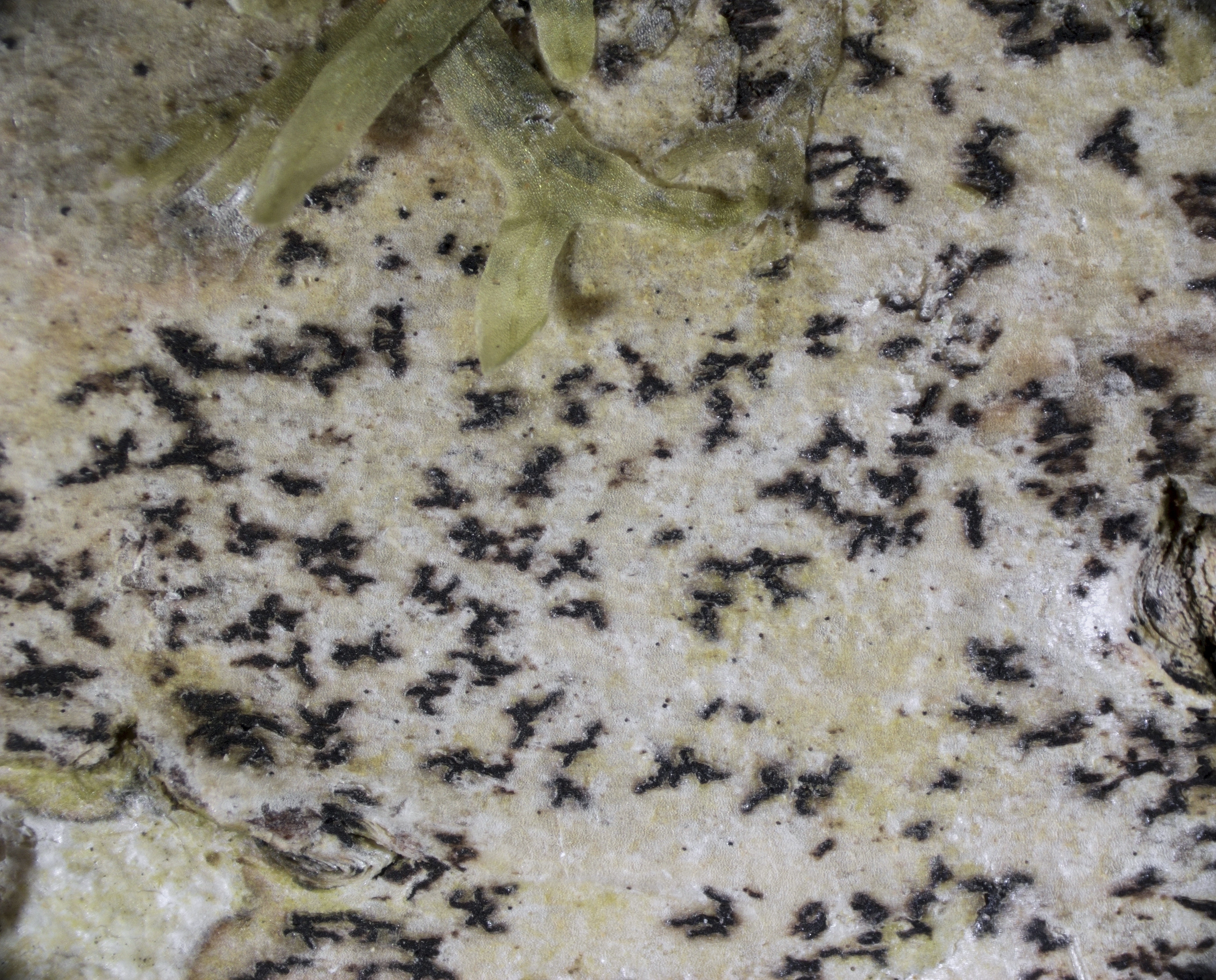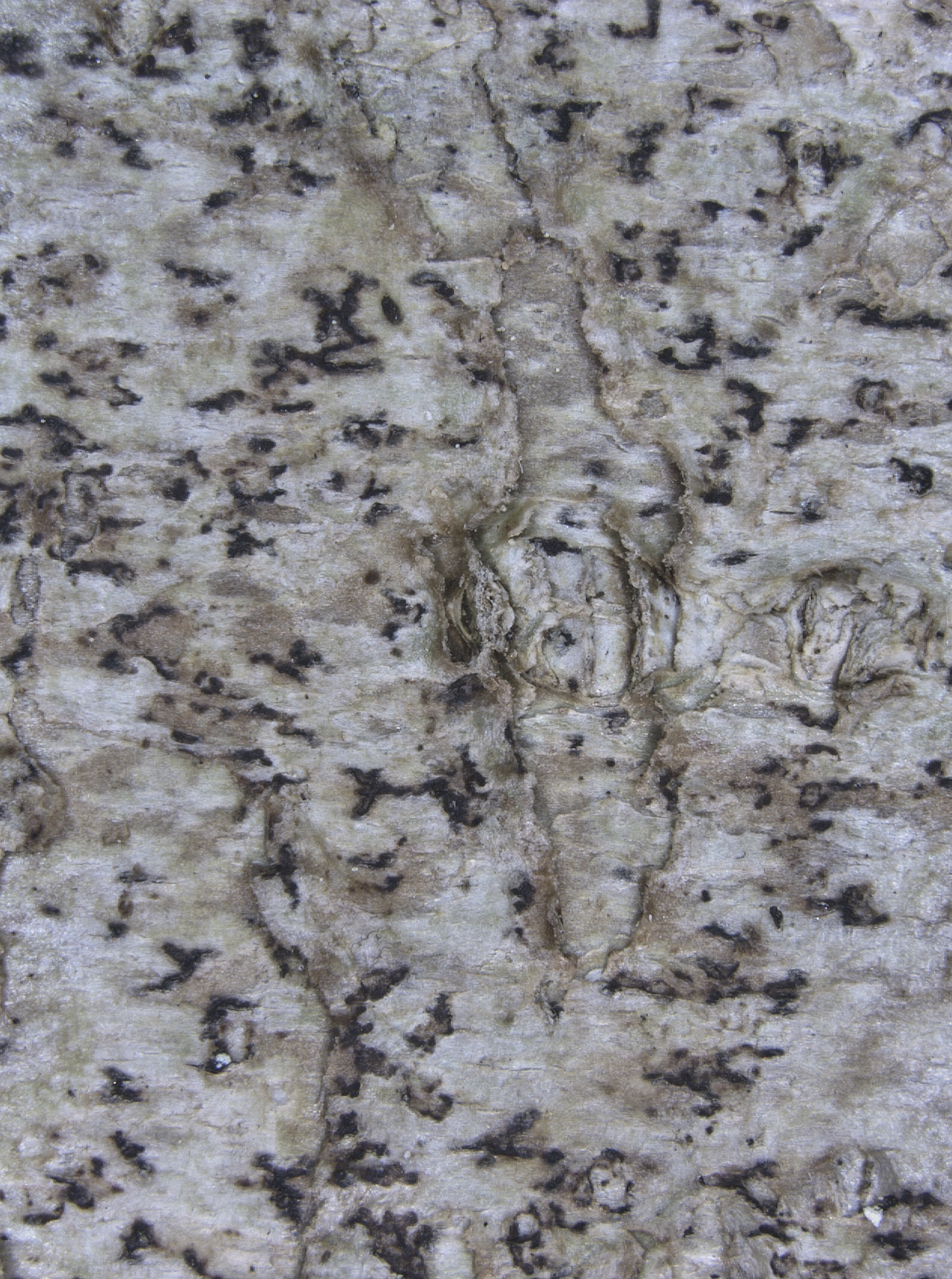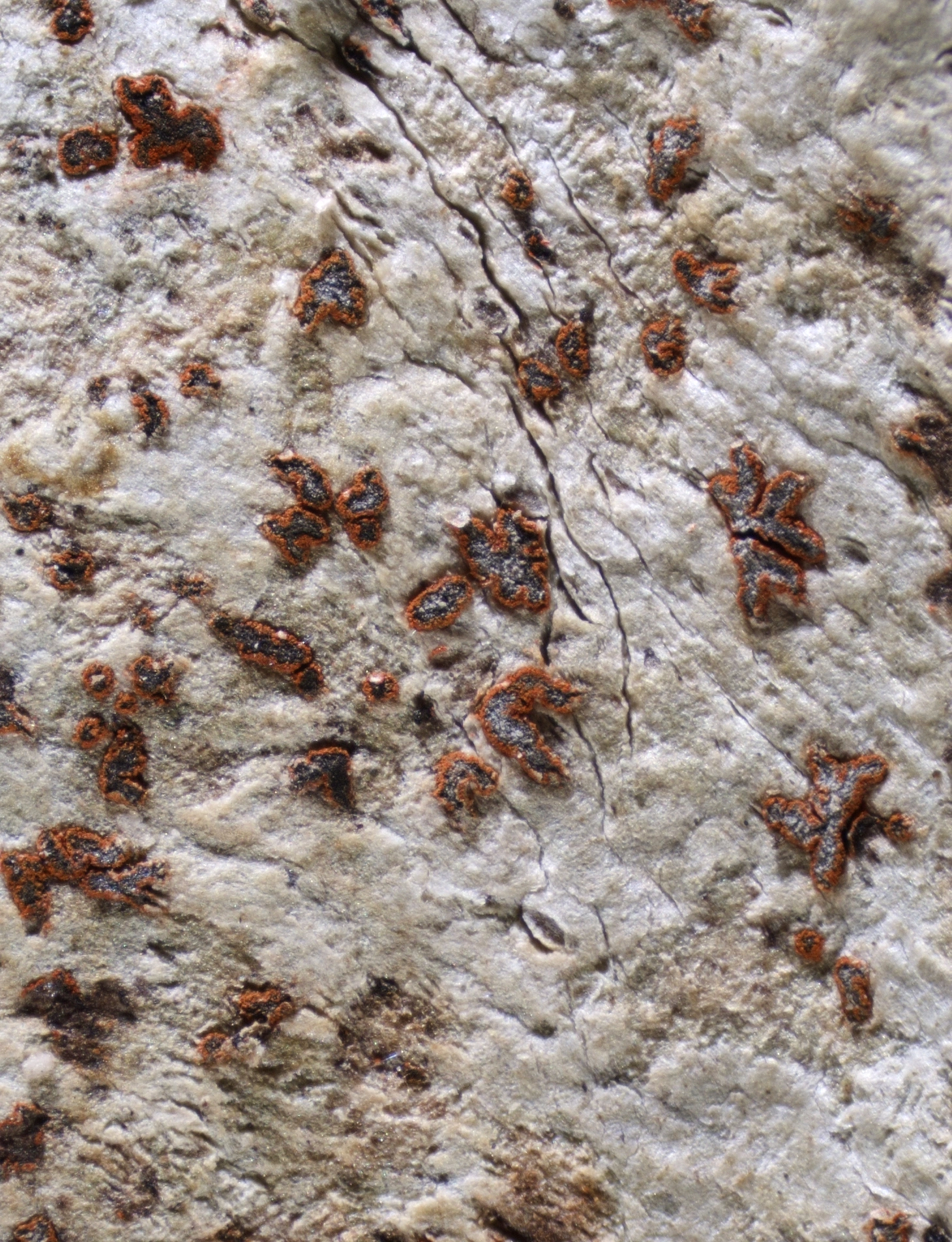Arthonia stellaris
Arthonia stellaris collected from Corylus avellana at Beltestadtjørna-Hovdanes N in Tysnes (O-L-226339).
Arthonia stellaris grows on smooth bark of deciduous trees in oceanic forests and woodlands from Rogaland to Møre og Romsdal. It is recognized by reddish brown to brown-black, narrowly elongated to star-shaped apothecia on a thin thallus with trentepohlioid photobiont. The brown and warted spores are divided by 3–4 transverse septa, the apical cell is enlarged.
- Innhold
- Description
- Ecology
- Distribution in Norway and the Nordic countries
- Global distribution
- Similar species
Arthonia stellaris collected from Corylus avellana at Beltestadtjørna-Hovdanes N in Tysnes (O-L-226336).
Description
Thallus
The thin thallus is immersed in the host bark and greenish white, light grey or pale fawn. The margin is bordered by a brown line or it is not determinate. The photobiont is a species of the family Trentepohliaceae.
Fruitbodies
The apothecia are level with the thallus surface or indistinctly raised. Their shape is narrowly elongated to irregularly branched or star-shaped. The apothecia are reddish brown (when moist) to brown-black and do not have pruina. They are sometimes covered by a thin layer of bark cells. They are up to 2 mm large, with individual branches 0.08–0.15 mm wide, and 60–95 μm tall. The disc is flat.
The epithecium is 5–10 μm tall and reddish brown.
The hymenium is colorless to pale reddish brown and 40–50 μm tall.
The hypothecium is indistinct or up to 20 µm tall, colorless or pale reddish brown.
The paraphysoids are 1–1.5 μm wide. Their tips are slightly widened to 2 µm, brown pigmented or with distinct dark pigment plaques.
The asci are clavate or obovoid, 40–45 × 17–20 µm in size, and 8-spored.
The spores are colorless first, with a brown pigmentation and granular ornamentation when old. They are obovoid to narrowly obovoid, 13–24 × 5–9 μm in size, and are divided by (2–)3–4 transverse septa. The apical cell is enlarged.
Anamorph
The pycnidia are brownish black, immersed in the thallus, and 40–60 µm in size. The wall is reddish brown in color. The rod-shaped conidia are 4.5–5.5 × 0.5–1 μm in size.
Chemistry
The thallus does not react with C, K, KC, Pd or UV (C–, K–, KC–, Pd–, UV–). An unidentified lichen secondary compound called the “stellaris unkown” has been detected by TLC.
The hymenium reacts I+ red mottled with blue and KI+ deep blue. A KI+ blue ring structure has been observed in the asci.
The brown pigment in the epithecium and the wall of the pycnidia changes to greenish in K solution.
Arthonia stellaris (Norway)
Ecology
Arthonia stellaris grows in western Norway in highly oceanic forests and woodlands including the boreo-nemoral rainforests. The species is usually found below 200 m elevation and often occurs on smooth bark of common hazel (Corylus avellana). It is further observed on a variety of deciduous trees including birch (Betula ssp.), European ash (Fraxinus excelsior), European beech (Fagus sylvatica), holly (Ilex aquifolium), oak (Quercus spp.), and rowan (Sorbus aucuparia). Outside Norway, it is also reported from European silver fir (Abies alba).
Distribution in Norway and the Nordic countries
Arthonia stellaris is confined to Norway in the Nordic countries. The species is widespread in oceanic coastal Norway from Rogaland to Møre og Romsdal.
Global distribution
Outside the Nordic Countries, Arthonia stellaris is known from oceanic or high rainfall areas in western and central Europe, Macaronesia and North America.
Arthonia stellaris (Norway)
Similar species
Arthonia stellaris is an easily identified species that is characterized by reddish brown (when moist) to brown-black, narrowly elongated to star-shaped apothecia on a thin thallus that is immersed in the tree bark and often rather inconspicuous. The spores with 3–4 transverse septa are brown and distinctly warted when old. The apical cell is enlarged. Among the species with transversely septate spores and an enlarged apical cell, Coniocarpon species differ by the crystalline red to purple pigmentation in the fruitbodies that dissolves in K with a clear purple solution. A white or orange-red pruina on the apothecia is found in all species except C. cuspidans.
Reichlingia anombrophila is another species growing in similar habitats as A. stellaris. It can be distinguished by the typically pale olive-grey, felty thallus, and apothecia with a thin white pruina that are split by deep fissures into branched or star-shaped aggregations of angular to rounded or elongated partial fruitbodies. The spores are smaller than in A. stellaris, 12–15 × 4–5 μm in size, and are divided by 2–3 transverse septa.
Literature
Cannon P, Ertz D, Frisch A, Aptroot A, Chambers S, Coppins BJ, Sanderson N, Simkin J and Wolseley P (2020). Arthoniales: Arthoniaceae. Revisions of British and Irish Lichens 1: 1–48.
Coppins BJ (1989). Notes on the Arthoniaceae in the British Isles. Lichenologist 21: 195–216.
Wirth V, Hauck M and Schultz M (2013). Die Flechten Deutschlands, vol. 1+2. Ulmer, Stuttgart. 1244s.





